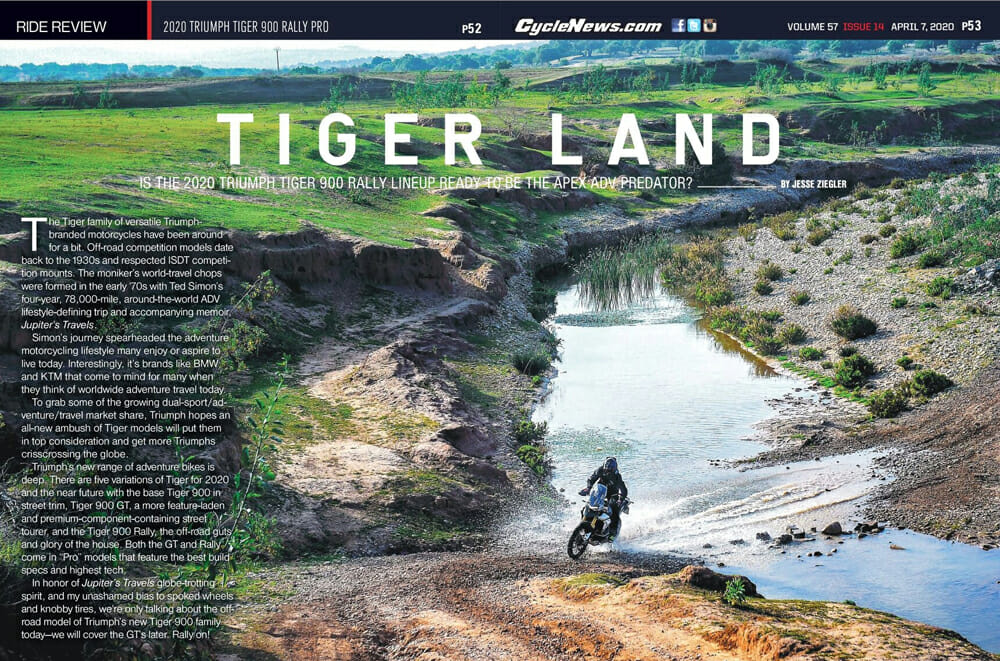Jesse Ziegler | April 10, 2020
2020 Triumph Tiger 900 Rally Pro Review
Is the 2020 Triumph Tiger 900 Rally lineup ready to be the apex ADV predator?
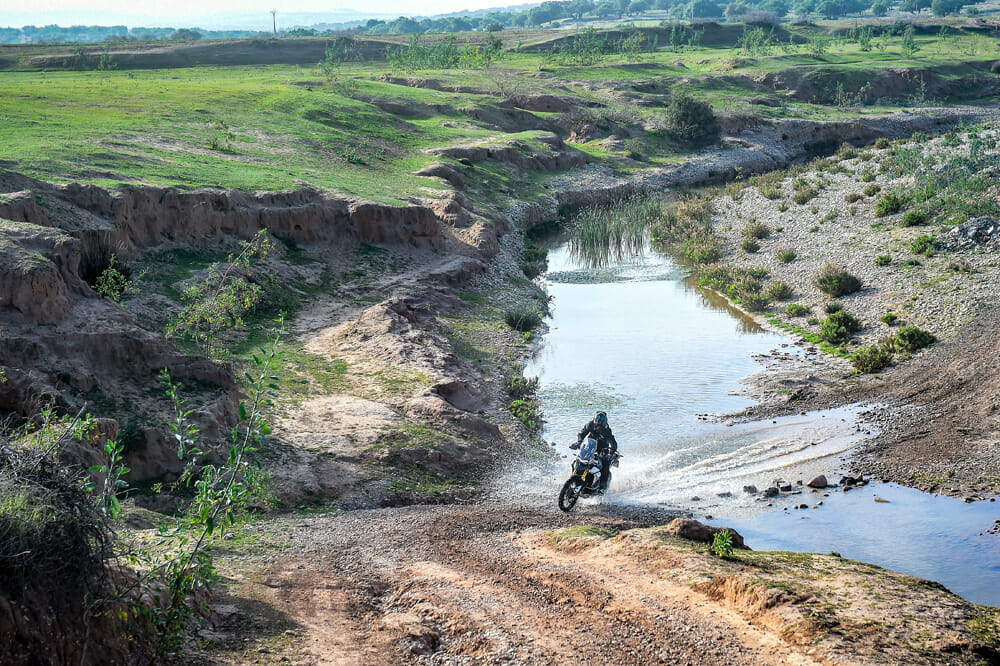
Photos by Triumph/Kingdom Creative
The Tiger family of versatile Triumph-branded motorcycles have been around for a bit. Off-road competition models date back to the 1930s and respected ISDT competition mounts. The moniker’s world-travel chops were formed in the early ’70s with Ted Simon’s four-year, 78,000-mile, around-the-world ADV lifestyle-defining trip and accompanying memoir, Jupiter’s Travels.
Simon’s journey spearheaded the adventure motorcycling lifestyle many enjoy or aspire to live today. Interestingly, it’s brands like BMW and KTM that come to mind for many when they think of worldwide adventure travel today.
To grab some of the growing dual-sport/adventure/travel market share, Triumph hopes an all-new ambush of Tiger models will put them in top consideration and get more Triumphs crisscrossing the globe.
Triumph’s new range of adventure bikes is deep. There are five variations of Tigers for 2020 and the near future, with the base Tiger 900 in street trim; Tiger 900 GT, a more feature-laden and premium-component-containing street tourer; and the Tiger 900 Rally, the off-road guts and glory of the house. Both the GT and Rally come in “Pro” models that feature the best build specs and highest tech.
In honor of Jupiter’s Travels globe-trotting spirit, and my unashamed bias to spoked wheels and knobby tires, we’re only talking about the off-road model of Triumph’s new Tiger 900 family today—we will cover the GTs later. Rally on!
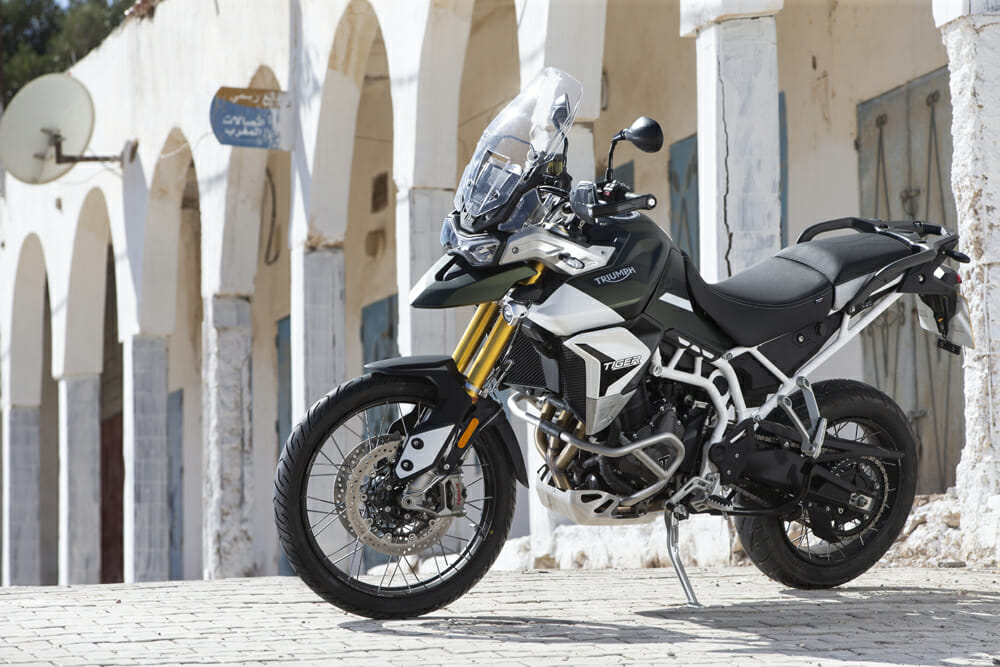 The Tiger 900 gets more displacement and less weight. Nothing wrong with that!
The Tiger 900 gets more displacement and less weight. Nothing wrong with that!
2020 Triumph Tiger 900 Rally Pro Review | The 800cc Bias in The Room
For the past decade, Triumph Tiger adventure bikes have been most well-known as 800cc triples. And—we might as well get this over with—I haven’t really liked them. Most bikes are great, alone, until you ride others. And when you ride all of them on varying terrain for days, things pop up that you love, and things show up that you dislike. The previous-generation Triumph Tiger 800s look cool and sound great, but seem cursed with awkward ergonomics when standing up for multi-terrain use. Also, they can be fairly awkward when sitting down. Even today I see photos of people riding them and think, “Hmmm, I remember that feeling, and I think I’d make a different choice.”
Regardless of my opinion, their triple-cylinder soundtrack will have anyone smiling all day, and if all you care about is smiling, this is great.
The multi-terrain capabilities and performance DNA of the Tiger have always been present as a dirt-roader and rev-limit-loving joyride, but the pedigree Jupiter’s Travels bestowed on Triumph as a top choice to take around the world. For me, this is lost in translation (even though both are very English) on most of the 800s.
Apart from that, you could buy a nice used Tiger 800 at a value today just for the sound they make and I would consider it a good purchase. Smiling! There’s virtually nothing in common between today’s Triumph Tiger 900 and yesterday’s 800. I think that’s good news for all of us. And as we go through the build of the modern Tiger and how it performs, I’m sure you’ll see it as a different animal, as well.
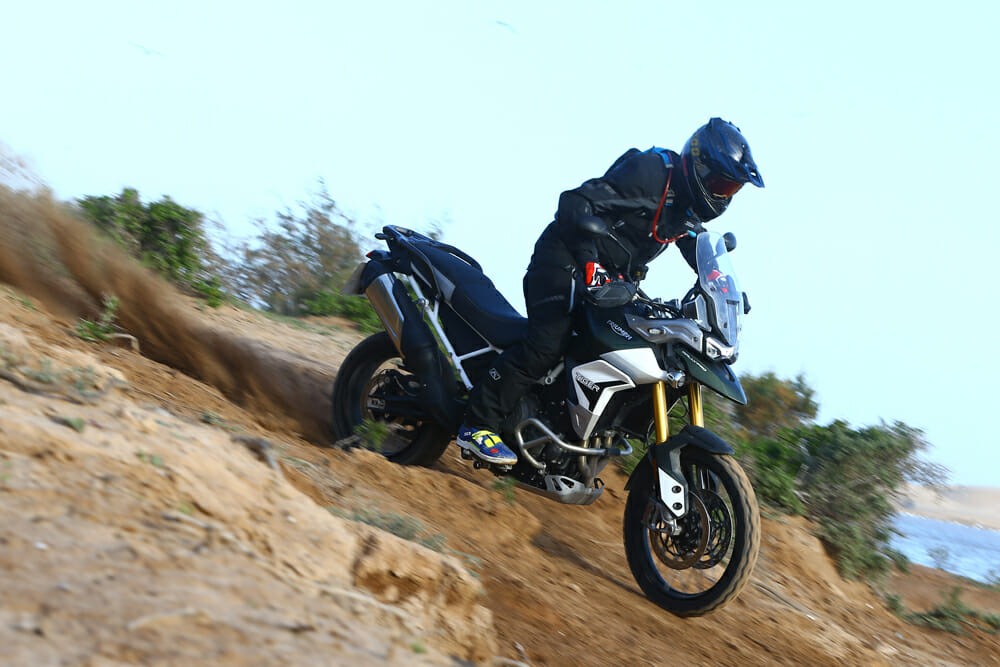 Rider aids are abundant but can be turned off when needed.
Rider aids are abundant but can be turned off when needed.
2020 Triumph Tiger 900 Rally Pro Review | Universal updates
Across the board, all Triumph Tiger 900 models get a complete rebuild from the older generation. The steel frames are lighter and more ergonomically pleasing, and the replaceable aluminum subframe now thankfully has removable bolt-on passenger pegs. Fuel tanks are larger (5.28 gallons/20 liter) and narrower, bar positions and footpeg placements are optimized for each model and the riding conditions likely to be encountered. Weight is lower and more centered. Everything you touch and see is new. This is good news.
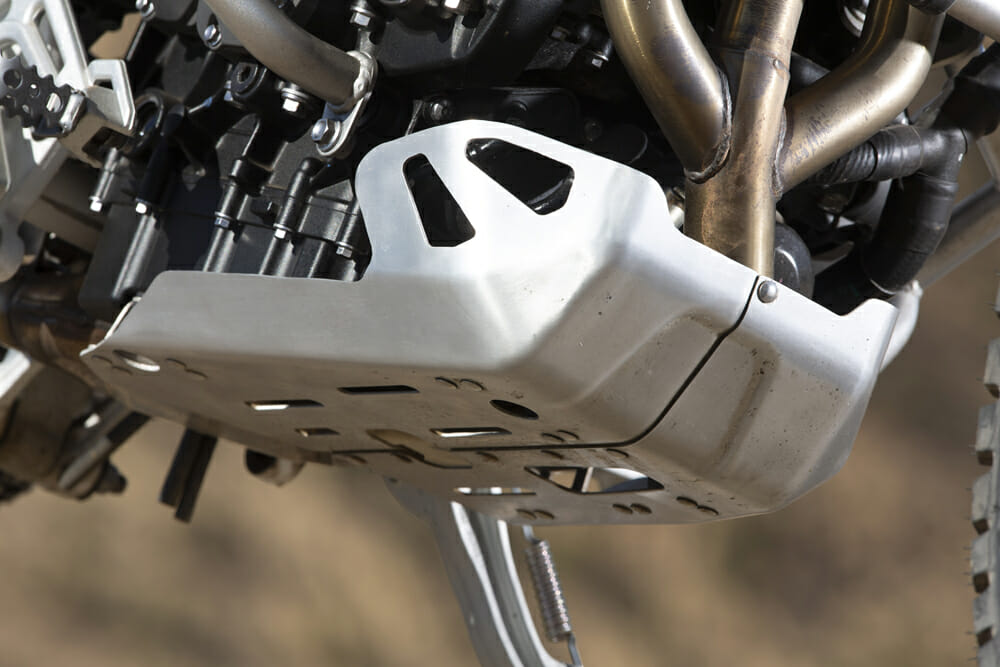 Triumph didn’t skimp when it came to engine protection. The skid plate definitely wasn’t an afterthought.
Triumph didn’t skimp when it came to engine protection. The skid plate definitely wasn’t an afterthought.
2020 Triumph Tiger 900 Rally Pro Review | Engine
Starting with the obvious, the new Tiger 900 comes with a more powerful, more advanced, cleaner and lighter powertrain in the 888cc triple engine. Headlining the engine’s hype reel after displacement upgrades is a new T-Plane crankshaft and 1-3-2 firing order at varying degrees off crank position.
Triumph is proud of its triples (as it should be) but twin-cylinder torque and usable power delivery of modern mid-sized, liter-ish ADV motorcycles might have sparked some jealousy in the Triumph engineering department. This new T-Plane crank and firing order, combined with updated internals throughout the engine, intends to deliver twin-like torque with the spirit and soundtrack of a triple.
Triumph’s T-Plane crank fires uniquely, starting with 180-degrees of rotating fire from cylinder one-to-three, and then firing cylinder two 270-degrees after. Cylinder one fires again after another 270-degrees. This drops two combustions of tire-hate closer together as the crank spins to give the feeling of a twin at lower speed and rpm. In theory, the triple can still come alive and make you smile when opened up.
Overall, there’s a claimed 10-percent increase in torque and more horsepower across the board before meeting the old 800’s curve at the very top. So, on paper, the 900 is delivering the goods with the engine update.
In reality, it does more than deliver. The new Triumph Tiger 900 power character is nearly perfect for an adventure bike, especially one getting dirty like the Tiger 900 Rally. For variable terrain, having controllable and substantial power is king. And this engine will move you over obstacles and around turns without excessive rpm required to motivate. Also, the torquey bark negates unnecessary wheel slip and you get to actually hang on and enjoy the ride.
If you admire traction-loving power, you’ll appreciate the healthy upgrade here.
The propulsion is as contagious as the exhaust note’s new, more pulsing tone. Think of a drumline rat-a-tat-tat-tatting with a feline growl and you’ll hear what is happening here. The two go hand-in-hand, symbiotically willing you to keep cracking the throttle so you can feel the power and hear the exhaust and feel the power to hear the exhaust again and again.
From standing up aggressively on two-track to cruising through urban landscapes, the new Triumph Tiger 900 is a powerhouse where I prefer power, off-idle and through the mid with little concern for the highest rpm.
For those of you looking to scream this ride out and surge like a Moto2 champion, you’ll be a little let down as the impressive bottom and midrange fall off up top. But I say it’s a well-earned tradeoff.
Shift and smile.
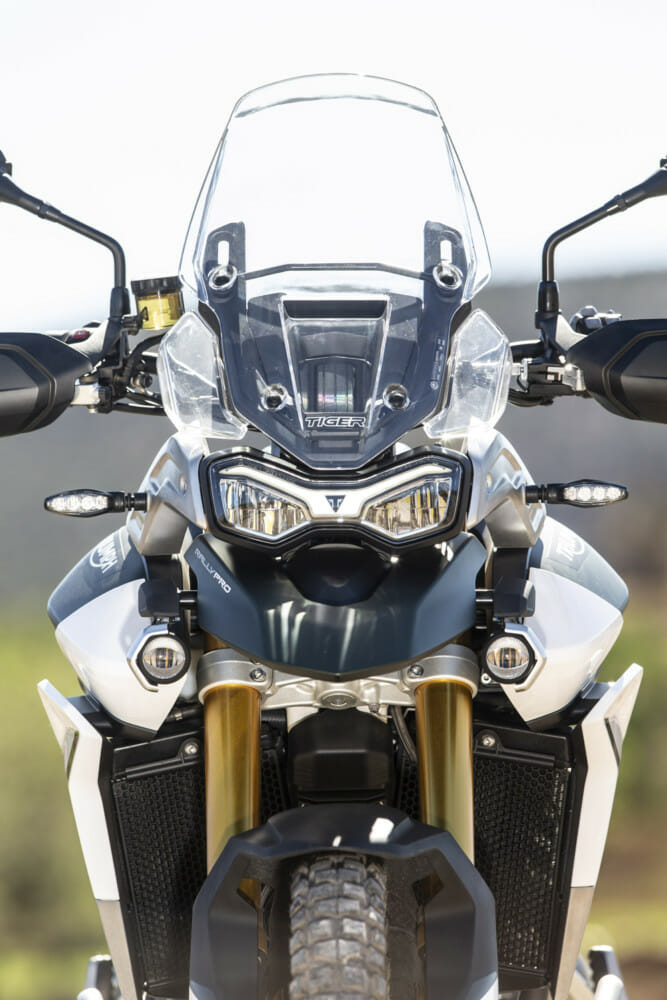 The Triumph Tiger 900 is ready to go face to face with any ADV bike on the market.
The Triumph Tiger 900 is ready to go face to face with any ADV bike on the market.
2020 Triumph Tiger 900 Rally Pro Review | Suspension, Running Gear, Riding Modes
After the engine impresses, it’s up to the suspension componentry and running gear to connect all that goodness to the earth and continue the goods. And Triumph has spec’d high-quality parts on the Tiger 900 Rally models to continue the confidence.
A Showa 45mm fork with manual preload adjustment and full circuit damping via clickers provide 9.4 inches of front-wheel travel. Comparatively, the new Tiger 900 GT has seven inches of travel. Showa handles rear-shock duty, as well, with a preload- and rebound-only adjustable nine inches of travel.
Both suspension components work well on and off-road. Having a fully adjustable fork is a nice feature and the shock works well despite it lacking compression adjustments.
The Akront, outer rim-spoked tubeless wheels (21-inch front and 17-inch rear) provide a good platform for all-terrain travel with a wide array of tire options available for their size. Not as historically robust as center-pull spoked wheels for aggressive off-road romping, these wheel styles still hold up fine for most rider’s needs. We ripped Pirelli Scorpion Rally tires for our off-road excursions and, as the factory-approved tire spec, they worked great. We only had one front flat in our group and the Moroccan countryside wasn’t exactly smooth.
Mounted up on the wheels are some serious brakes. Brembo four-piston Monobloc Stylema front calipers clamp dual 320mm discs via a radial front master cylinder while a Brembo rear caliper grabs a 255mm disc for sweet skids courtesy of your right boot.
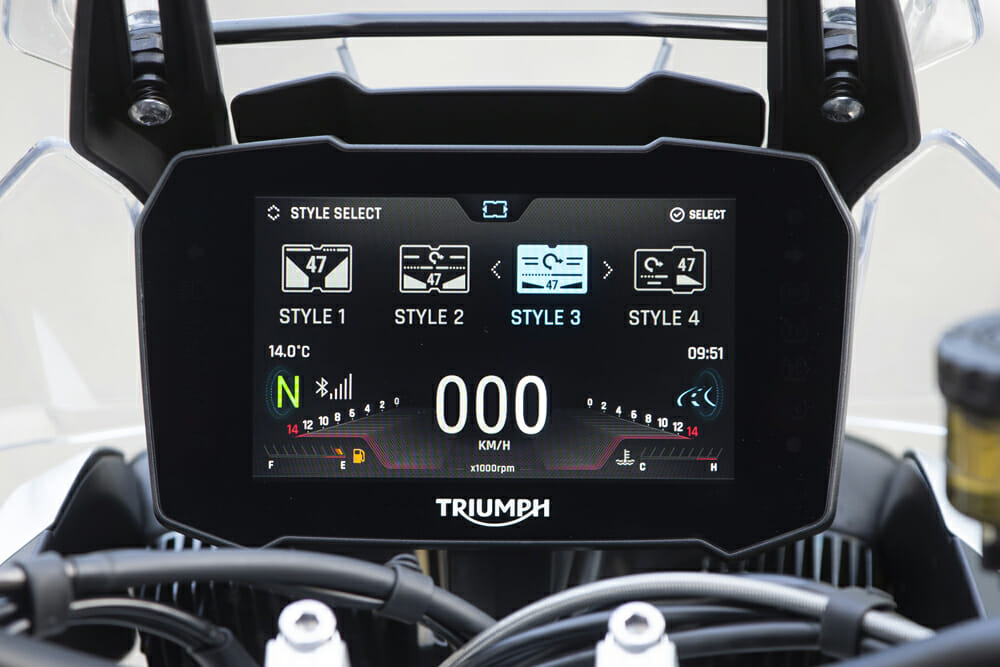 The seven-inch TFT meter has it all, including good looks.
The seven-inch TFT meter has it all, including good looks.
2020 Triumph Tiger 900 Rally Pro Review | ABS Traction Control
When it comes to rider aids, Triumph has done some great homework for the Tiger 900 Rally. While it contains all the on-road ABS and Traction Control tech as it’s GT counterpart, it features off-road specific robot control, as well.
Standard aboard is a new optimized-cornering ABS that adapts the braking performance based on the lean angle, automatically. There are three standard modes: Road, Off-Road and Off. Traction Control follows suit with cornering-enable tech intervening wheelspin at varying degrees dependent on lean. Here, riders have five levels of settings with Road, Rain, Off-Road, Sport and Off.
All rider aids are controlled by an Internal Measurement Unit (IMU) via Continental. This little do-dad measures Roll, Pitch, Yaw and Acceleration rates to calculate the lean angle and apply the proper parameters for traction control and ABS systems. The result is a more stable ride. Thankfully, Triumph has given you the keys to turning it all off at will.
Additionally, there are six riding modes available (depending on build spec) that combine these systems and throttle response/mapping. Rain, Road, Sport, Off-Road, Rider (pilot-set preferences) and, unique to the Tiger 900 Rally Pro model, Off-Road Pro. Off-Road Pro disables all ABS and Traction Control and provides the most aggressive throttle map available to keep it lively in the grit.
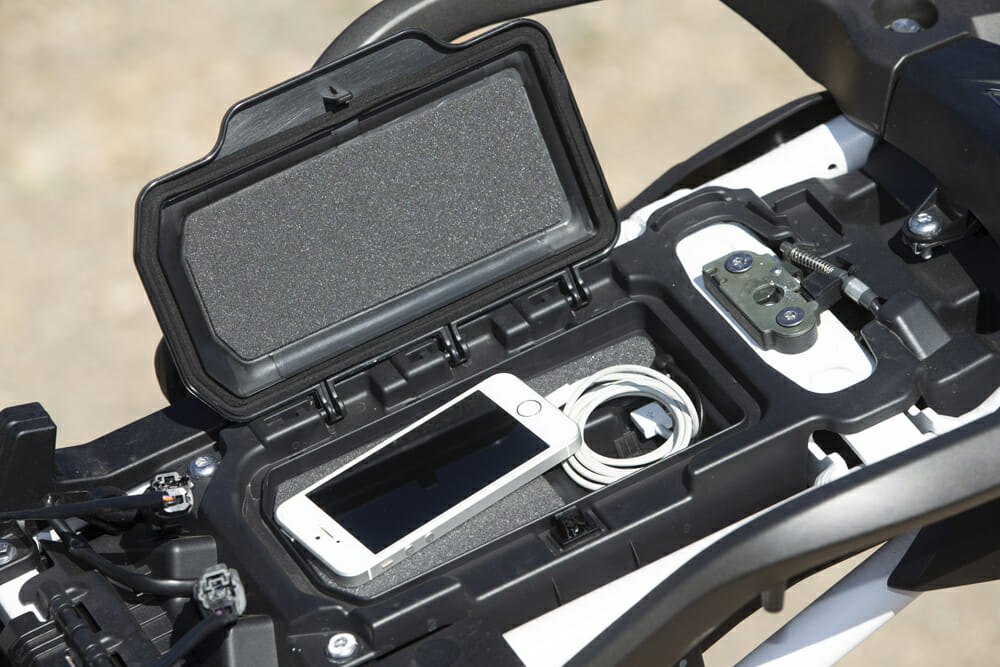 Your phone is well protected but not conveniently accessed, which isn’t good when a photo op suddenly appears on your adventure ride. (And there should be lots of those!)
Your phone is well protected but not conveniently accessed, which isn’t good when a photo op suddenly appears on your adventure ride. (And there should be lots of those!)
2020 Triumph Tiger 900 Rally Pro Review | Pro Upgrades
What makes it Pro, anyway? Well, as most premium builds, the Tiger 900 Rally Pro gets all the good stuff at a $1700 premium on the starting price tag. But the other Rally model is nearly there. Going Pro gives you the full suite Triumph Connectivity System, Triumph Shift Assist (quick shift), illuminated switchgear on the handlebar, LED fog lights, center stand, tire pressure monitoring, engine protection bars, aluminum skid plate, heated rider and passenger seats, and the Rider selectable Riding Mode. That reads like a lot and the price tag to get it is reasonable. But the biggest addition to Rally Pro is the Off-Road Pro riding mode. There’s no way to replicate that on the base Rally as the Off-Road throttle map is unique. That’s probably worth going pro. And the heated seats. Toasty buns are nice and hard to price.
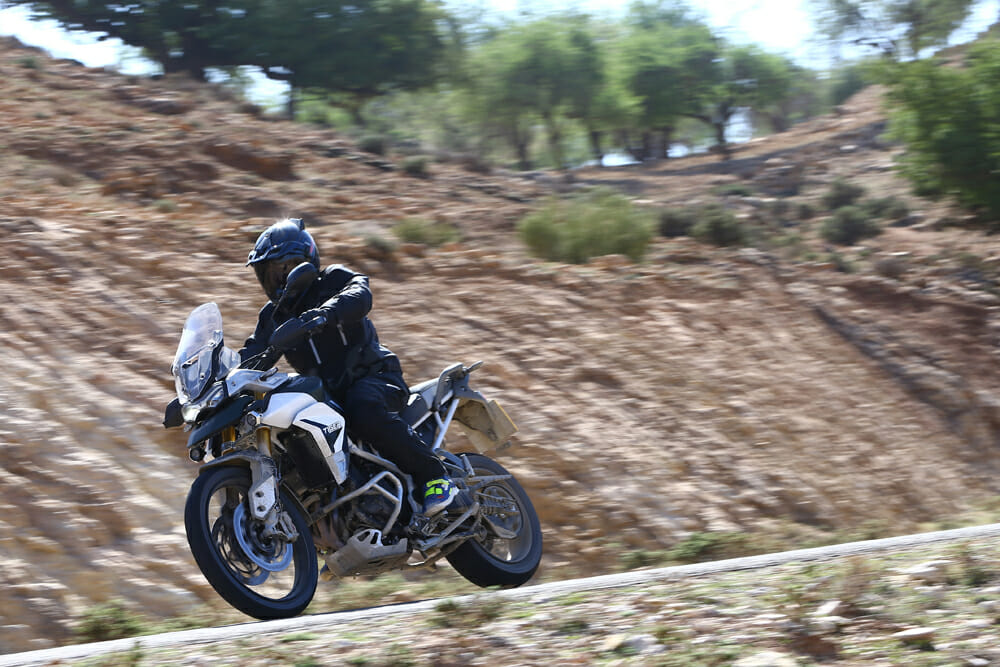 There isn’t much the Tiger 900 Rally can’t do. It’s also quite comfortable on the road.
There isn’t much the Tiger 900 Rally can’t do. It’s also quite comfortable on the road.
2020 Triumph Tiger 900 Rally Pro Review | Comfort and Convenience
The brass at Triumph are proud of their seven-inch color TFT dashboard and integrated Triumph Connectivity System. This dash and system come on all Tiger 900 GT and Rally models.
The dash is big and bright with minimal glare. Bluetooth connectivity is standard on Pro models so you can link your phone and/or comms system to the dash so you can see what you’re hearing and who’s calling, etc. If you’re using the My Triumph app to navigate from your smartphone, distance-to-turn and arrowed directional instructions will display but there’s no map option. You can operate phone calls and even your GoPro all from the handlebar-mounted controls.
For motorcycle data use, the screen view can be customizable in four different arrays of bike data. Those are all available in four different colors or a high-contrast option (white background). Most of the dash screens are dominated by large digital graph representations of a tachometer (some going in multiple directions), big numbers for speed, gear indication, mpg, range and smaller fonts for time, temp, heated grip/seat settings and more. And also riding modes. In short, a lot is going on. I found all the color options underwhelming and hard to process. So, I stuck to high-contrast and luckily found an analog tach so I could tell where the engine was running.
Do you know what I really want this screen to do? Show my phone-navigation apps like Waze, Google, Apple Maps, Rever or others. Those apps are superior at navigating, circumnavigating traffic and providing copious amounts of information. Plus they have built-in search, so if I need to find a gas station anywhere in the world, they can do that.
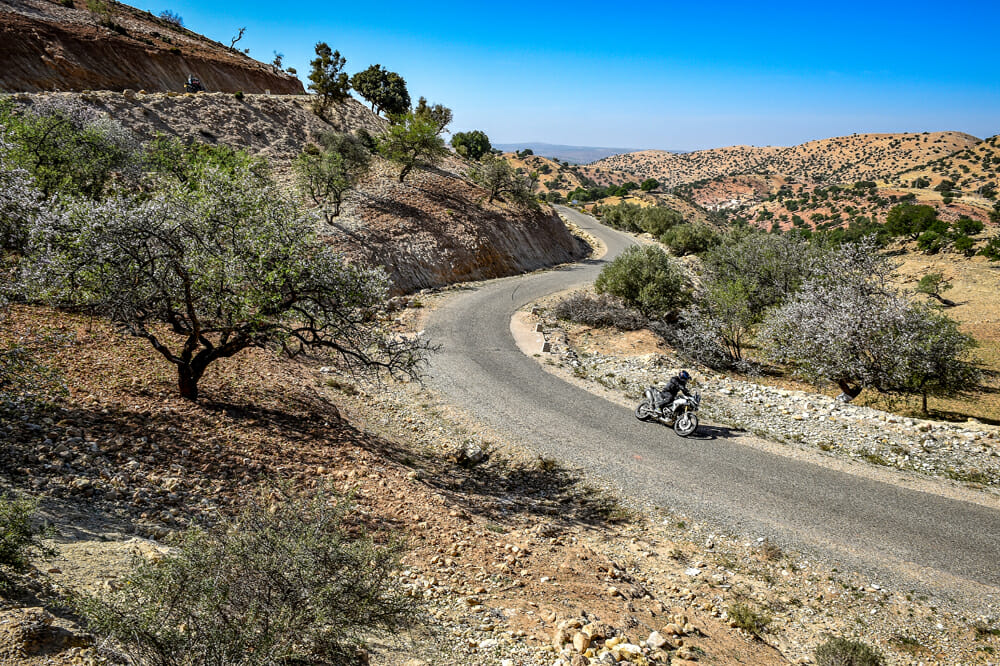
Speaking of phones, Triumph has a good charging and connection system for your $1000 addiction. It’s nearly perfect. Their under-seat phone storage box has a dedicated charging port and protects the contents from dust and water. As the phone is connected to the bike via Bluetooth, all the calls and music and navigation functions operate while the phone is safe and secure. The only downfalls are my previous complaint about my on-phone apps being invisible and I have to take my seat off to take pictures with my phone—which I do all the time. The storage solution is a great idea. Maybe it’s in the wrong spot. Until that’s resolved, I’m going to mount my phone on my bars like most nerds.
There are more premium features on this ride than I can remember without referencing my notes. All the lighting is full LED (maybe not the U.S.’s turn signals). All GT and Rally bikes get an electronic cruise control standard that is electronically adjustable. Yes, button throttle! Heated grips are similarly standard and there are standard USB and 12v power sockets on board.
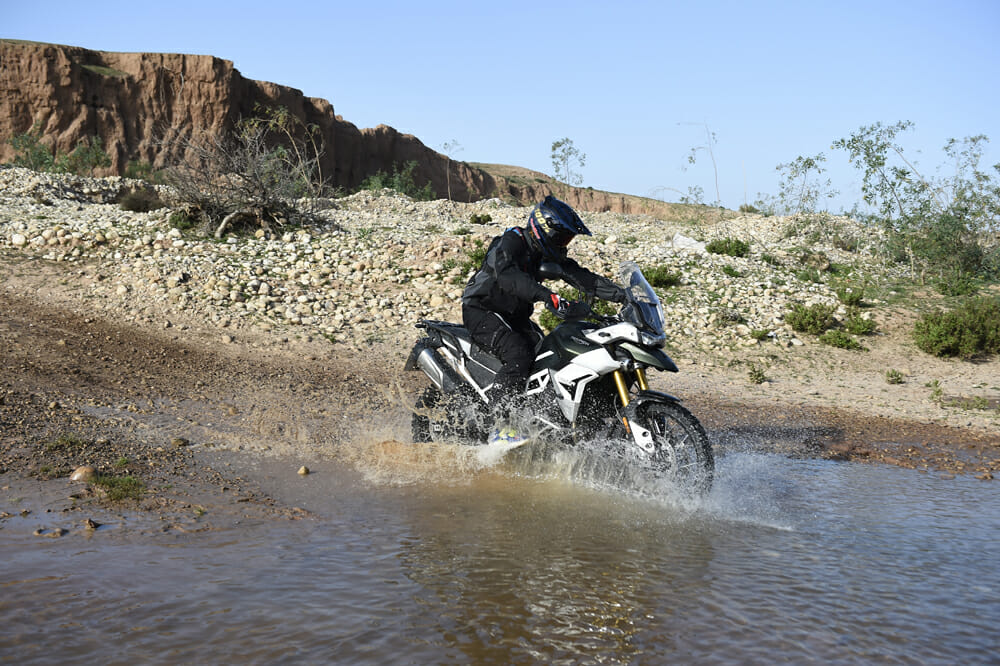 Triumph has a boatload of accessories for the Tiger 900.
Triumph has a boatload of accessories for the Tiger 900.
2020 Triumph Tiger 900 Rally Pro Review | The Final Dirty Deets
No longer are you compromising real off-road ability and comfort on a Triumph Tiger for the look. This one performs as good as it looks and probably better. The engine and ergonomics upgrades from the previous generation immediately put Triumph in top-of-class contention for the crowded mid-size ADV space. The engine is fantastic for the bike and where it should be ridden. The suspension and handling, thanks to dropping weight from the bike all around and moving the balance more intelligently to the center, mean you can get rowdy and enjoy it more. It’s lost none of its triple-cylinder heritage or soul and it showcases a premium option for those getting away from German and Austrian bikes. I only have reservations on petty things like the computer-screen readout.
I think the Triumph Tiger 900 looks better than ever. I know it works better than ever.CN
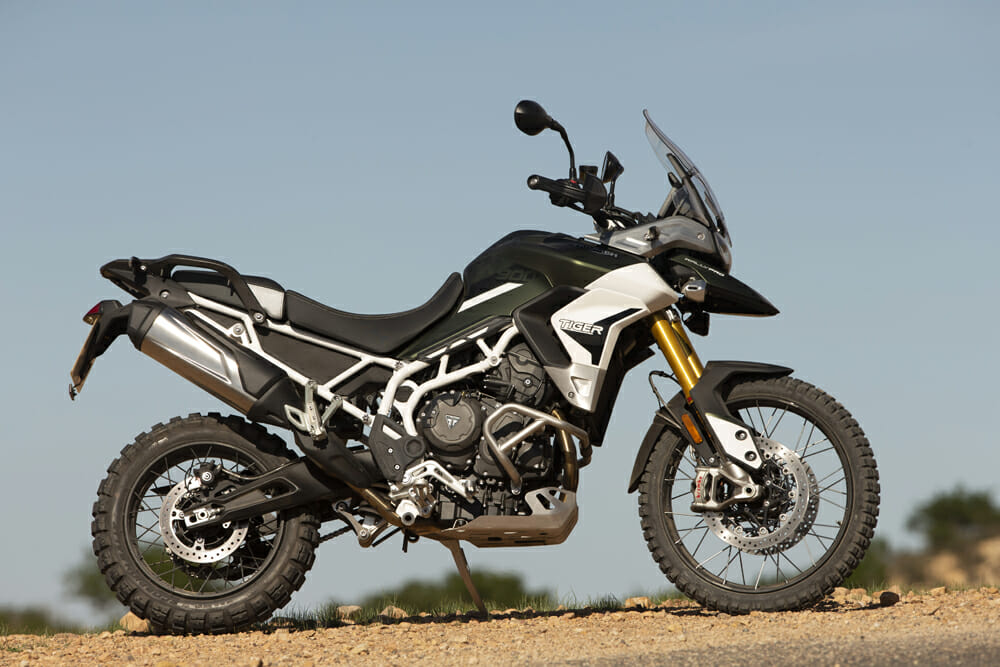
2020 Triumph Tiger 900 Rally Pro Specifications
|
|
| MSRP: |
$16,700 |
| Engine: |
Liquid-cooled, 4-stroke, 12-valve, DOHC, inline, 3-cylinder |
| Displacement: |
888cc |
| Bore x Stroke: |
78mm x 61.9mm |
| Compression Ratio: |
11.27:1 |
| Max Horsepower (claimed): |
95.2 PS / 93.9 bhp (70 kW) @ 8750 rpm |
| Max Torque (claimed): |
87 Nm at 7250 rpm |
| Fuel System: |
Multipoint sequential electronic fuel injection |
| Exhaust: |
Stainless-steel 3-1 header system, side-mountain stainless-steel muffler |
| Final Drive: |
O-ring chain |
| Clutch: |
Wet, multi-plate |
| Transmission: |
6-speed |
| Frame: |
Tubular steel frame, detachable subframe |
| Front Suspension: |
Showa 45mm, USD, fully adjustable |
| Rear Suspension: |
Showa, single shock, spring preload, rebound damping adj. |
| Front-Wheel Travel: |
9.4 in. |
| Rear-Wheel Travel: |
9.1 in |
| Swingarm: |
Twin-sided cast aluminum alloy |
| Front Wheel: |
Spoked, tubeless, 21 x 2.15 in. |
| Rear Wheel: |
Spoked, tubeless, 17 x 4.25 in. |
| Front Tire: |
90/90 x 21 in. |
| Rear Tire: |
150/70R x 17 in. |
| Front Brake: |
Twin 320mm floating discs, Brembo Stylema, 4-piston Monobloc calipers, radial front master cylinder, Optimized Cornering ABS |
| Rear Brake: |
Single 255mm disc, Brembo 1-piston sliding caliper, Optimized Cornering ABS |
| Rake: |
24.4° |
| Trail: |
5.7 in. |
| Seat Height: |
33.5-34.3 in. |
| Wheelbase: |
61 in. |
| Weight (dry, claimed): |
443 lbs. |
| Fuel Capacity: |
5.3 gal. |
| Fuel Consumption (claimed): |
55.4 mpg |
| Emissions: |
Euro 5 |
| Colors: |
Matte Khaki, Sapphire Black, Pure White |
